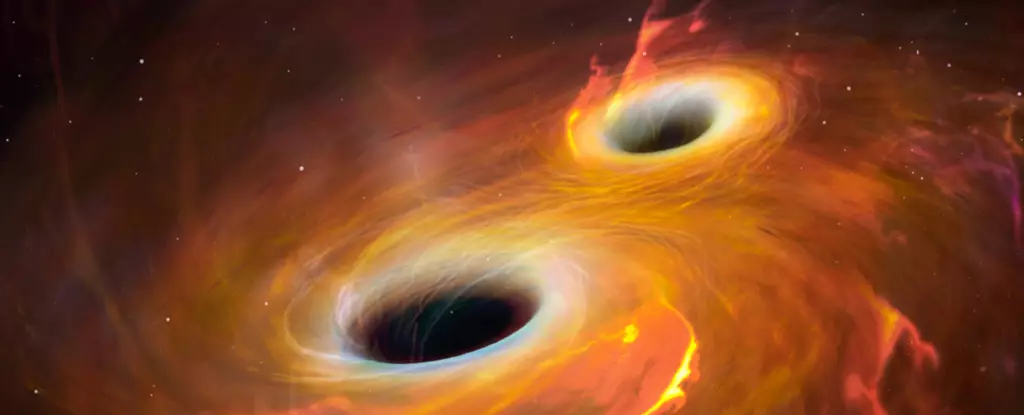Our universe is a grand tapestry of mystery and intrigue; at its heart lies the supermassive black hole, Sagittarius A* (Sgr A*), which anchors our Milky Way galaxy. Surrounding this enigmatic entity are not just scattered stars, but a myriad of phenomena including young stars, gas clouds, dust, and, intriguingly, stellar-mass black holes. While we often picture black holes as solitary figures lurking in the shadows of space, current research suggests that the area around Sgr A* is far more dynamic—an intricate dance of matter and energy unfolding within a veil of interstellar debris that obscures our vision in visible light. Instead, we rely on infrared and radio waves to peel back the layers of this cosmic onion, but the stellar-mass black holes remain elusive, shrouded in a scientific enigma.
The Mystery of Stellar-Mass Black Holes
Estimating the number of these stellar-mass black holes is no straightforward task. Traditional astrophysical models have suggested a meager count of around 300 black holes in close proximity to Sgr A*. However, an emerging perspective backed by a recent study published in Astronomy & Astrophysics posits that the true numbers could be staggering. The authors propose a re-evaluation based on the unique environment at the galactic center, where gas and dust intermingle in higher densities than elsewhere in the galaxy, fostering the birth of massive stars that are destined to meet dramatic ends as supernovae.
Such massive stars have fleeting lifetimes, collapsing into black holes and ultimately contributing to a recycling process that generates further star formation. This self-replenishing cycle signifies that the central region could become incredibly densely populated, functioning almost like a cosmic mill or a “star grinder.” Within this dynamic realm, black holes could accumulate to the point where they influence their surroundings profoundly, creating a perilous environment for any star that dares to traverse this cosmic landscape.
The Star Grinder Model
Dubbed the “star grinder,” this model presents a provocative and captivating narrative of cosmic evolution. If the calculations hold merit, we could be looking at millions or even billions of stellar-mass black holes per cubic parsec around Sgr A*. This raises an unsettling prospect: any star straying too close might find itself in grave danger, as black holes would exert a gravitational influence capable of tearing stars apart. This interaction could catalyze yet more star and black hole formation, exponentially increasing the density of black holes in the area.
The concept raises a captivating question: how do we substantiate this theory? Here is where the statistical concept of “collision time” comes into play, introducing a mathematical framework to analyze the interactions between stars and black holes. The collision time emanates from the density of black holes, as well as the sizes of the stars involved. A higher density correlates to shorter collision times, and larger stars are more susceptible to succumbing to the gravitational pull of black holes.
The researchers behind this star grinder model conducted rigorous analyses, calculating collision probabilities across various spatial distributions, and then comparing those estimates with real observational data. What becomes apparent is that the larger O-type stars, often the most prominent in any stellar assembly, are conspicuously fewer in the heart of our galaxy compared to other sectors. This scarcity hints at a troubling reality: those massive O-type stars are likely being “ground” down by encounters with black holes, whereas more numerous B-type stars seem to enjoy a safer existence away from direct black hole interactions.
Hypervelocity Stars: The Evidence Lies in Their Speed
Another twist in the tale involves hypervelocity stars—those nimble celestial bodies that hurtle through our galaxy at astonishing speeds, often on trajectories that indicate they’ll escape its gravitational embrace altogether. Roughly a dozen of these extraordinary stars have been detected, and their origins have spurred significant scientific debate. If the environment around Sgr A* is as populated with black holes as the star grinder model suggests, then it provides a plausible mechanism for how hypervelocity stars achieve such remarkable velocities. Close encounters with black holes could impart the necessary energy to propel these stars to escape velocity, giving credence to the hypothesis.
As we push the boundaries of our understanding of the cosmos, the implications of these findings cannot be understated. This notion of a black hole-dense region disrupting the very fabric of stellar formation poses new questions about the behavior of stars and the evolution of galaxies. The complex interplay among black holes and stars near Sgr A* not only deepens our appreciation of cosmic mechanics but challenges us to reconsider our models of galactic evolution. The mysteries of the universe continue to unfold, promising new revelations at every turn.

